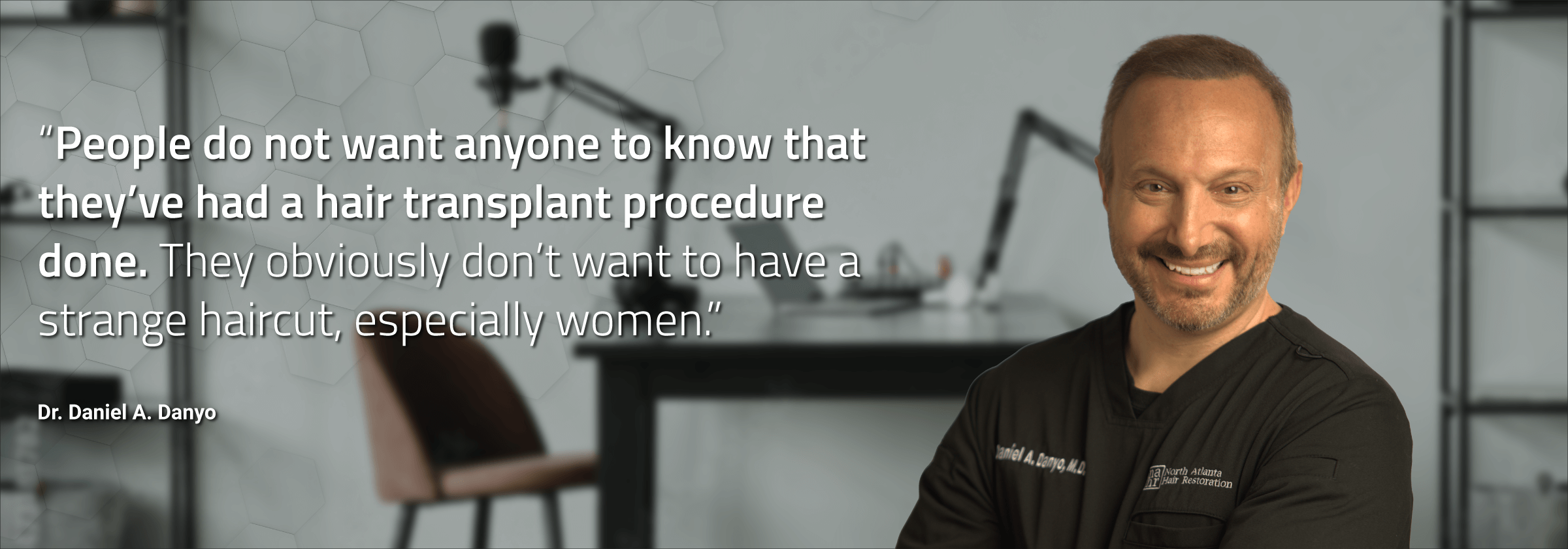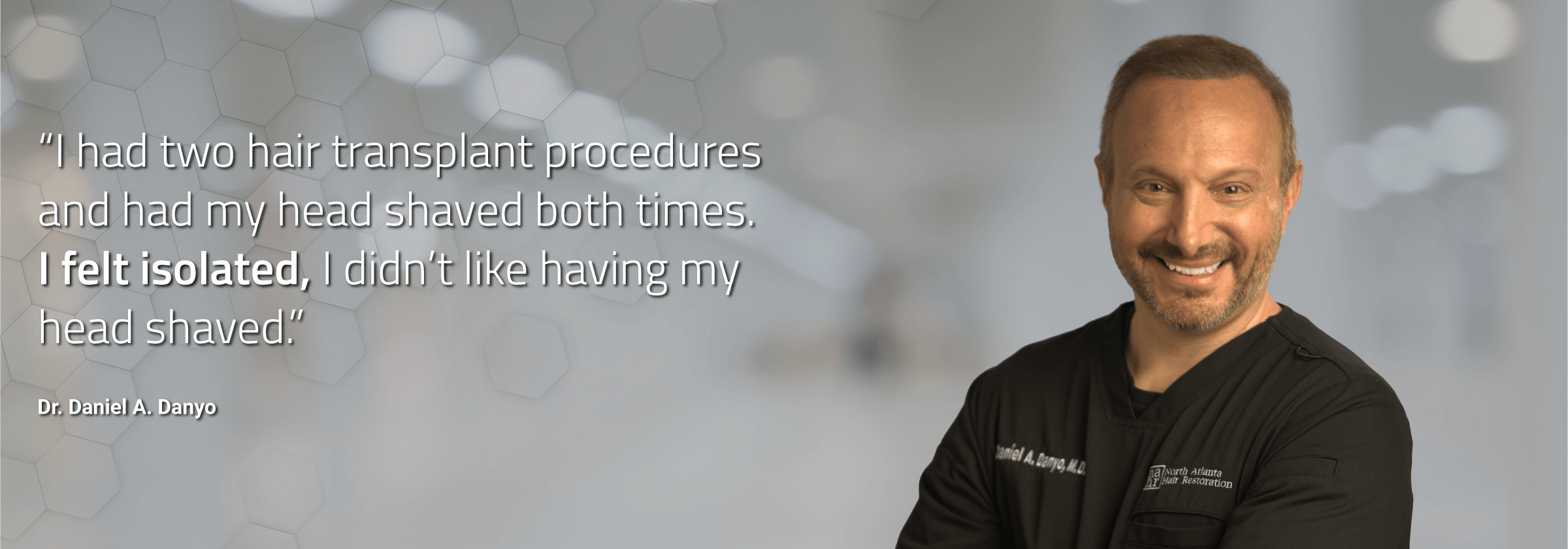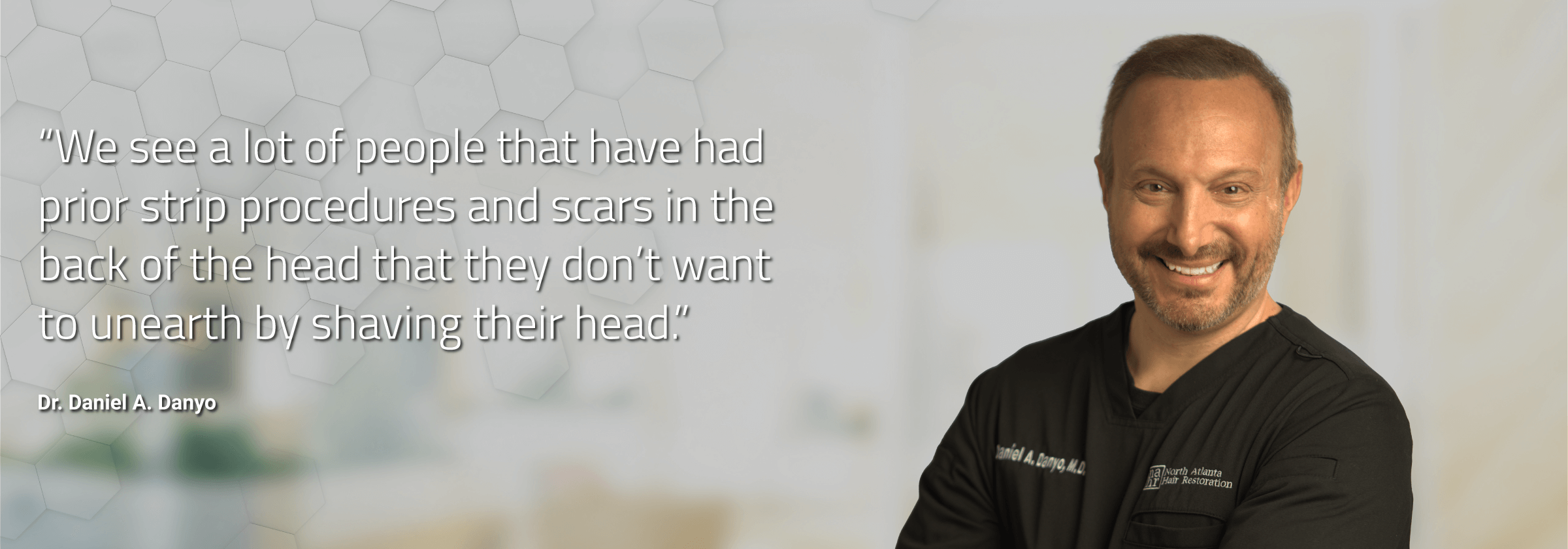The following is a transcript of Episode 2 of the Hair Restoration With Dr. Daniel A. Danyo podcast.
All episodes of the podcast can be found at Apple Podcasts, Google Podcast, and Spotify.
Clark: Yeah, it’s a lot. Do you normally find people when they’re exploring this, are they…how often are they referring back to the old days of…is that a common fear?
Dr. Danyo: Well, they, I mean, first they don’t want, you know, like a pluggy look and if you’re doing single follicular, you know, placement, and that can be anywhere from like one to four hairs but in creating natural hairlines, especially with using single hairs, I mean, you’re not gonna get a pluggy look, it’s gonna look natural. But really, you know, FUE or Follicular Unit Excision came out to get those single units, but do it in a way that you did not have a linear scar.
So traditional FUE actually requires the hair that you extract to be short. So the easiest way is to literally just shave the head. And I would say the majority of FUE done in this country and really, around the world is done with either part of the scalp shaved or the entire head shaved, and that’s just not something that most kind of working, you know, people or social people can do easily, unless they have like two or four weeks to take off. And that’s how kind of this kind of shave-less also called non-shaven or unshaven approach to FUE then came to life.
Clark: Wow. And you become globally sought out for this?
Dr. Danyo: Yeah, so, you know, shave-less or, you know, unshaven or non-shaven FUE is really hard to do. And first off, I mean, FUE, in general, is extremely hard to do. And there are so many variables in hair type, skin type, so each case is different. And when you’re oftentimes extracting 1500, 2000, 2500, even 3000 follicles and trying to get close to 100% success rate on each follicle, it takes, you know, a lot of skill to do it and it takes a lot of patience. And then when you throw in, long hair around where you’re actually extracting the grafts it’s kinda like going on a long, long drive in the snow. You’re gonna get there. It takes a little bit longer.
Clark: Take your time.

Dr. Danyo: But it takes a lot of practice to actually drive well in the snow. I know that firsthand because I’m a Northerner in the South.
Clark: Right, you don’t get much snow in North Atlanta?
Dr. Danyo: Yeah, people can’t drive in the snow down here, no question about it.
Clark: You get that eighth an inch and it’s gonna shut down the city.
Dr. Danyo: Yes. So, you know, why would somebody, you know, wanna kinda search me out, or wants a Shave-less FUE and the reason is concealment. People do not want anyone to know that they’ve had a hair transplant procedure done. They obviously don’t wanna have a strange haircut, especially for women. They don’t want any part of their head shaved. Even if you shave out a little box. And it really opens up the possibilities for people to do hair transplant when the other barriers that, you know, like the linear scar, the plugginess and then the shaved head or weird haircut are now eliminated, it opens the door. And that’s kinda where the popularity has been.
So, really, they’re searching me out because, you know, I do this 80% of the time on my practice. I mean, that’s what I’m known for, which means we’re practicing almost on a daily basis to deliver high-quality grafts at high numbers and doing an excellent job concealing the donor site and the fact that a procedure was done. And I, as a physician, I think we, you know, we talked about it in the first podcast, I do the bulk of the work, I do all of the extractions as far as coring the grafts with a mechanical device. I do all the neuro blocks and anesthesia and I actually place all the hairs. And that’s just another, you know, reason for somebody to choose me, you know, along with the Shave-less FUE.
Clark: And that’s not the most common way, I mean, a lot of times you’ll meet the doctor and you kinda get passed along from person to person. And I remember this in our kickoff episode, we were focused so much on just the passion that you have, your background, but also the relationship because it’s important to form and you really go from start to finish.
Dr. Danyo: Yeah, well, you know, I treat my patients, you know, like I would wanna be treated and it’s not a sales job for me and, you know, kinda being invested in the patient and then kinda investing my time and extra energy to do a shave-less procedure, especially when they’re, you know, above 2000 or 2500 grafts. You know, a lot of people have told me that, well, you can’t do that many shave-less in a day, well, and it’s something that we do frequently.
And the fact is, I’m totally invested. I have, over years practiced the art of doing this procedure to where I’m able to block out the other hairs or distortions of the view, because of, you know, bleeding that you can’t really see with extra hair around or, you know, kinda different angles that I’ve been able to do this successfully just based on my passion and really just based on practice. And the fact that it’s not being done universally is because of the extreme difficulty with actually doing it.
Clark: I’m curious about this. So how do you get started doing this? I hear what you’re saying, it’s really challenging. It sounds really complicated. How do you get started?
Dr. Danyo: Yeah, well, I went to…it’s about six years ago, I went to a course and I was sitting, listening to a lecture where somebody was talking about and showing pictures of a unshaven or, you know, Shave-less FUE. And he said, “This is extremely hard to do, we’re only doing 500 grafts at a time and it’s taking us, you know, long time to do 500 grafts. We’re just kind of doing it for smaller cases and definitely not for bigger cases and, you know, this is something that you can shoot for, but keep in mind, it’s extremely hard.” So, you know, I had two hair transplant procedures and had my head shaved both times.
And for me, it was just a royal bummer. I mean, just, you know, I felt isolated, I didn’t like having my head shaved. I didn’t really wanna go to school events for my kids or kinda go out. We’re pretty social. So I felt isolated for about three to four weeks and I just imagined what my patients would go through. And not to mention, I had multiple patients that said, “Well, I can’t have my head shaved. So I’m just, I can’t do it.” So I saw a real need after that lecture to say, “You know what, I’m gonna get good at this. I’m gonna practice it.” And, you know, I started doing…my first case, I think, was 200 grafts. It took me probably six hours to do.
And then we went up to 500. And then we went up to 1000. And I’ve actually done 3100 shave-less in a day. And it was not a very, you know, drawn-out affair. I mean, we’ve gotten so fast at it that we can now do shave-less procedures faster than most people can do shaved procedures. And, you know, again, it’s a practice thing. I am trained, my staff is trained as well, as far as cleaning as far as, you know, creating spaces, pulling grafts [inaudible 00:14:21] chord. It’s really an orchestra. And, you know, that takes place when we’re extracting and doing a shave-less procedure. So everybody in the team has to be on board. You have to develop the eyes and the skills to do it.
Clark: Wow, so you were sitting there, you hear the, you know, the expert say, “You know, you really can’t do this more than 500.” And you just, challenge accepted?
Dr. Danyo: Yeah, and even a recent course that I went to somebody was talking about shave-less and said, “We limit it to 1500 grafts in a day. That’s as much as we can do.” So, you know, I just feel because we’ve made it a priority and made, you know, something that’s deemed a big deal and kinda marginalized that in our minds to where this is routine, it’s not a big deal. And so, you know, we can get pretty large cases done, even 2500 grafts in a very reasonable time, usually about the time of a workday, instead of like 11, 12, 13 hours that people report, you know, having to do from a time standpoint, because it’s a lot more laborious.

Clark: Certainly, is there anything else that we’ve not talked about that explains how it works?
Dr. Danyo: Yes, so that, you know, the Shave-less FUE really, it just has a lot of advantages for one, let’s say you’re like a high-level guy, maybe CEO of a company or you’re out in the public eye. And you need, you know, 2000, 2500 grafts to fill in, but you really don’t want to [crosstalk 00:16:15].
Clark: Is that like a full…? How many grafts does just if you didn’t need a procedure, how many grafts would you normally have? Does that make sense?
Dr. Danyo: Oh, in your head?
Clark: The whole head.
Dr. Danyo: Well, I mean, where we pull grafts somewhere from the side and back of the head, so there are probably, you know, 8,000 to 10,000, you know, grafts, maybe up to 12,000. So, you can actually take up to 50% of those hairs if done properly before there’s thinning in the back.
Clark: If you’re taking that like, almost like a pore out? Is it like a pore?
Dr. Danyo: Yes, yes, you have a round kind of punch that we use it around oscillating, trumpeted punch that basically scores the whole follicle, and then we manually pull the grafts.
Clark: Well…
Dr. Danyo: So it’s a tedious process…
Clark: Right, I mean, you’re doing that pore by pore?
Dr. Danyo: Yeah.
Clark: Or, you know, graft by graft?
Dr. Danyo: Graft by graft absolutely.
Clark: Is it by hand? Is it, well…
Dr. Danyo: You know, let’s say that you were doing 2000 grafts and you added a second, you know, for each 2000 grafts, just on the extraction side, you’re talking about an extra half hour about, you know, 2000 seconds. And so, you know, there’s gotta be a momentum as you’re doing these in velocity. You have to keep moving. So you have to do the proper things to keep the vision intact. You know, while you’re still getting grafts and my assistants are behind me pulling the grafts, I mean, we have to work with sometimes really long hair, sometimes it’s shorter.
But, you know, like I said it’s an orchestra. But the nice thing about shave-less is I can do whatever number of grafts you want at one time because you don’t have to have a weird haircut. Typically, if you shave your head, you’re like, “All right, just do as much as you can.” You know, but it gives people the option, like this morning, I did a shave-less eyebrow case of 300 grafts. And she walked out…obviously, you could see the grafts in her eyebrows, but her hair in the back there were no short hairs left. We didn’t shave any part of the scalp. You know, she’s gonna have a normal, you know, existence as far as the back of her head goes and that’s very satisfying for people.
But back to that CEO that’s in the public, I mean, you could do 500 grafts at a time and, you know, just kind of slowly build it up. And we did that for somebody and he was just totally happy. The other thing is we see a lot of people that have had prior strip procedures and scars in the back of the head that they don’t want to unearth by shaving their head. And we’re able to do, you know, Shave-less FUE around the scars and conceal them with the existing hair. And that’s a huge advantage.
Clark: Wow. Well, we’ve been talking a little about what it is, how it works. We’ve been certainly talking about the why behind it. Are there any other things that either have surprised you or maybe surprise from the clients you’ve worked with about this, things that you’ve learned over the years from this? Any other things on your mind?
Dr. Danyo: Well, I think the biggest thing is that when people leave the office because most of my patients are not like fully bald. I mean, people have hair loss. But they, you know, most of the patients that I see and I’d say 70% of the male patients have existing hair that so they can cover where we’ve actually grafted. So when you leave, and again, this can be a pretty large procedure and your donor site shows no evidence that you did any procedure, and then you can take the existing hair and kinda place over because we don’t need anybody to cut their hair up top and kinda cover the grafts that we placed. They walk out of here, and they can actually go out to eat, and nobody would know that they just had 2000 grafts.
Clark: Right then and there?
Dr. Danyo: What’s that?
Clark: You’re saying, you had a procedure and then you go out to dinner?
Dr. Danyo: Yeah, absolutely. I’ve had people even go to work the next day. I mean, the worst thing is I’ve had people say, “Well, I was thinking I had this procedure done before and I’m just gonna take two weeks off.” And it’s like, that’s ridiculous.
Clark: Whoa, no, you don’t need to that.
Dr. Danyo: I mean, our most frequent day is Thursday because we do it on Thursday. They got Friday, Saturday, Sunday, go back to work Monday.
Clark: Rocking and rolling.

Dr. Danyo: Yeah and part of the…and I call it the art of concealment is not only the Shave-less FUE but you have to put in the right amount of medicine and do the nerve blocks correctly. We use pen implanters instead of doing surgical slits with hand placements so that we have very clean grafting and really minimize any swelling in the face. So it is extremely rare that my patients have even a little bit of swelling in the face, let alone being, you know, almost debilitated from severe facial swelling which often happens after hair transplant.
So the combination of concealing the donor site, the graft area, the use of implanter pens, minimizing the medications, doing effective nerve blocks, and then having somebody without facial swelling is like those are all huge things. So when people come back, they’re just really happy that their life didn’t stop from a work standpoint, social standpoint. We have spouses pick up their husbands and they’re kind of peering into the door thinking they’re gonna see a freak show and they’re like, “Oh my gosh, this is nothing.” That’s a great feeling.
Clark: That’s gotta be the best feeling. I know that is so part of your heart and passion on this is seeing the loved ones and how they respond. I love it.
Dr. Danyo: Yeah, yeah. So, you know, my patients appreciate the extra work that we put in. We always hear it. You know I just said, “You guys hit it out of the park.” When I give them the mirror, or actually they thought that their hair in the back would look extremely thin and there’d still be evidence. They’re shocked when their donor site is concealed. And I would say the majority is sometimes if the hair is too short or really thin, you know, it may be a little noticeable, but not majorly so.
Clark: That’s great. I love it.
Dr. Danyo: Yeah, it’s all good stuff.
Clark: It’s good stuff. So, I’ve really enjoyed hearing just a bit more behind the scenes on what goes into this. I know there’s a lot more of course deeper on, you know, really in the weeds on how you do the work, actually do the procedure. But it all makes sense on the high-level view, the what it is, how it works, of course, the why behind it. And this has been really insightful. Any final thoughts you wanna leave us with?
Dr. Danyo: Yeah, you know, I think, you know, if you’re a physician listening to this, and you’re getting into hair transplant or you’ve been doing it and you’re trying to get into doing a shave-less procedure, I mean, there’s certain steps that you need to do. For one, maybe have part of the case be shave-less, especially in the beginning and start it out with even 100 or 200 grafts. You need to learn to use high-powered loop magnification.
I actually use 5.0, which is, you know, very magnified. And there’s no way you can do this with, you know, just kinda jeweler, you know, magnification at 2.5 magnification. It needs to be five to six times mag to really do this correctly. The problem is your visual field goes down with a higher magnification, but it’s something you’ve got to get used to in order to do it.
Clark: I can’t imagine. You’re good at what you do. Well, thank you again for taking the time to share a little bit about your work. I can’t wait for our next conversation soon.
Dr. Danyo: Sounds great, Clark. Thank you.
Clark: Thanks for listening to “Hair Restoration” with Dr. Daniel A. Danyo. You can book your consultation today with Dr. Danyo by simply calling (678) 845-7521 or online at nahairrestoration.com. And be sure to subscribe, rate, and review this podcast wherever you listen to your audio content.

